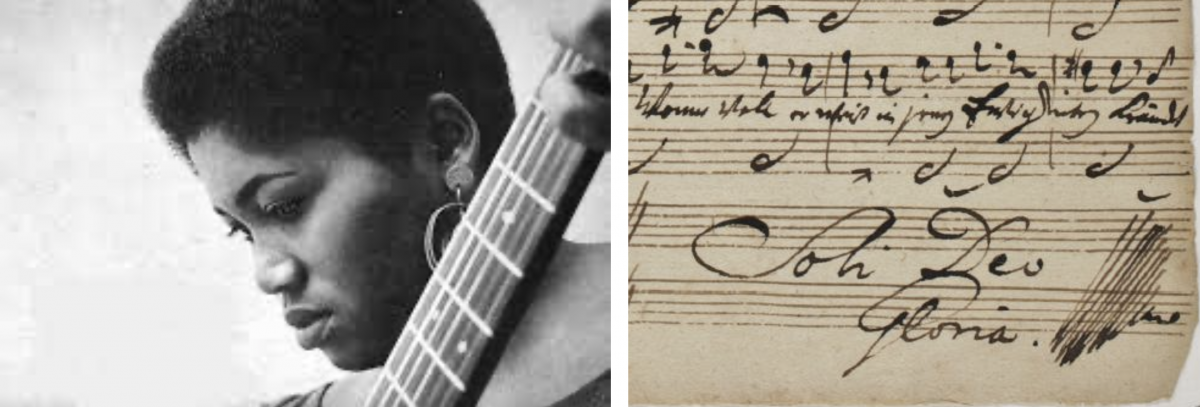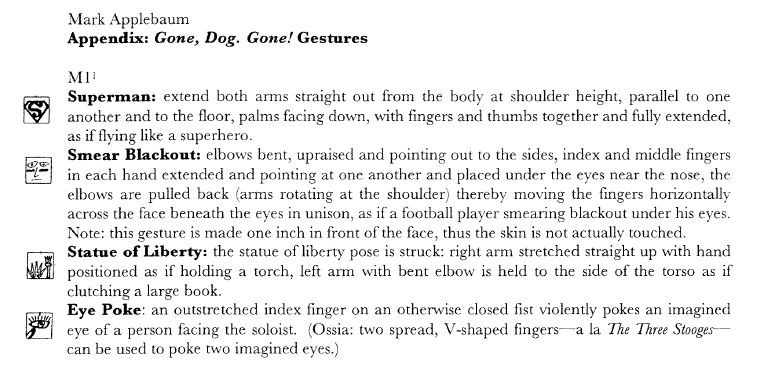Leon Fleisher (1928-2020)
Today is the first day without our dear Leon Fleisher amongst us. We are all so fortunate to have lived during his time, to have heard the truth he spoke through his playing, and to have witnessed the courage with which he fought to speak it.
—Seth Knopp
On July 23, 2017, Yellow Barn hosted an 89th birthday gala and party for Leon. For the first half of the program, Julian Fleisher joined his father in sharing stories and music from Leon's extraordinary life with music. We share those moments now, with joy and unending gratitude.
Odetta opens concert of Bach's cello suites

Odetta, with a detail of one of J.S. Bach's autograph manuscripts signed "Soli Deo Gloria" ("To the Glory of God Alone"), a dedication that the composer added to every piece of sacred music and many secular pieces as well.
On July 18, 2020, a recording of Odetta performing the spiritual "Glory, Glory" opened a concert of Bach Cello Suites at Yellow Barn. Following the concert, alumna cellist Annie Jacobs-Perkins wrote the following biographical note for Odetta:
In his letter to America penned days before his death, activist and Representative John Lewis summarized the words of Martin Luther King Jr. that meant so much to him as a young man. “He said we are all complicit when we tolerate injustice. He said it is not enough to say it will get better by and by. He said each of us has a moral obligation to stand up, speak up, and speak out. When you see something that is not right, you must say something. You must do something. Democracy is not a state. It is an act, and each generation must do its part to help build what we called the Beloved Community, a nation and world society at peace with itself” (New York Times, July 30 2020).
The folk and blues singer Odetta worked tirelessly to shape that Beloved Community. Born in 1930 in Birmingham, Alabama, she was a favorite artist of King’s and sang with him through many of the events that made him an icon in American history. She was there for the walk from Selma to Montgomery, King’s “I have a dream” speech, a civil rights demonstration for President Kennedy, and for countless other civil rights events. She is known affectionately as the “voice of the civil rights movement.” President Bill Clinton awarded her the National Medal of Arts and Humanities in 1999, and if she had not died from heart disease shortly before at age seventy-seven, Odetta would have performed at President Obama’s inauguration ceremony in 2008.
Although Odetta did not reach the huge popular success of folk artists such as Bob Dylan, Joan Baez, Harry Belafonte and Janice Joplin, all of them cite her as a major influence on their work. In a Playboyinterview from 1978, Dylan said that “The first thing that turned me on to folk singing was Odetta.” Odetta’s family moved to Los Angeles when she was six-years-old, and it was at that time that she began studying voice. She trained in opera and theater at Los Angeles City College, but realized her love of folk music during extra curriculars and self-reflection.
During an interview with The New York Times, Odetta stated that the recorded work songs she heard as a very young child in Alabama had a huge influence on her music—they served as a medium to find pride in self. In addition to her important role as an activist, Odetta is remembered for being unashamedly and unabashedly herself. At a time when black women faced social pressure to straighten their hair as a symbol of white respectability, Odetta appeared in front of thousands of audience members time and time again with her hair naturally curly. She said, “You’re walking down life’s road, society’s foot is on your throat, every which way you turn you can’t get from under that foot. And you reach a fork in the road and you can either lie down and die or insist upon your life.”
Watch the July 18th concert stream in its entirety:
2020 Yellow Barn videos
Watch performances from Yellow Barn's 2020 Summer Artist Residencies in Putney, Vermont.
View programs from the 2020 Summer Season
July 10, 2020 | View program details
Charles Ives Piano Sonata No. 2 “Concord, Mass., 1840–60”
Stephen Coxe Entstehung Heiliger Dankgesang (Emergence of the Holy Song of Thanksgiving)
Ludwig van Beethoven String Quartet in A Minor, Op.132 Heiliger Dankgesang eines Genesenen an die Gottheit, in der lydischen Tonart (Holy song of thanksgiving of a convalescent to the Deity, in the Lydian mode)
July 11, 2020 | View program details
Anton Webern Five Movements for String Quartet, Op.5
Benjamin Britten Elegy for Solo Viola
Antonín Dvořák Bagatelles, Op.47
Frederic Rzewski To The Earth
July 16, 2020 | View program details
Johann Sebastian Bach
Suite No. 1 in G Major, BWV 1007
Suite No. 4 in E-flat Major, BWV 1010
Suite No. 5 in C Minor, BWV 1011
Wer nur den lieben Gott läßt walten from Cantata, BWV 93
July 18, 2020 | View program details
Glory, Glory
Johann Sebastian Bach
Suite No.2 in D Minor, BWV 1009
Suite No.3 in C Major, BWV 1009
Suite No.6 in D Major, BWV 1012
July 23, 2020 | View program details
Mario Davidovsky (1934-2019)
Synchronisms No. 3 for Cello and Electronic Sounds
Synchronisms No. 6 for Piano and Electronic Sounds
Synchronisms No. 9 for Violin and Electronic Sounds
Synchronisms No. 11 for Contrabass and Electronic Sounds
Synchronisms No.12 for Clarinet and Electronic Sounds
July 25, 2020 | View program details
John Cage Solo for Voice 39 from Song Books
Franz Schubert Ganymed, D.544
Amy Beth Kirsten yes I said yes I will Yes.
Travis Laplante The Obvious Place
Toshio Hosokawa Windscapes
Beethoven Walks at Greenwood Trail and Hannum Trail
Ludwig van Beethoven Andante from Bagetelles, Op.126 No.3 in E-Flat Major
July 30, 2020 | View program details
Stephen Coxe The Very Hungry Caterpillar
Mark Applebaum Gone, Dog. Gone!
Fredrik Andersson The Lonelyness of Santa Claus
Alan Ridout Ferdinand for Speaker and Violin
John Cage Solo for Voice 57 from Song Books
John Cage Solo for Voice 22 from Song Books
Georges Aperghis Récitation No. 9 for Female Voice
Liza Lim Inguz
John Cage Solo for Voice 23 from Song Books
Matthew Aucoin Dual
Philippe Manoury Le Livre des Claviers II
Johann Sebastian Bach Partita No. 1 in B Minor, BWV 1002
Dimitri Shostakovich Seven Romances on Poems of Alexander Blok, Op.127
Osvaldo Golijov Tenebrae
James MacMillan Angel
2021 Yellow Barn videos
Watch performances from Yellow Barn's 2021 Summer Festival in Putney, Vermont.
Check back throughout the fall for more videos. Performances are being added weekly!
View programs from the 2021 Summer Season
Week one
Samuel Barber (1910-1981) String Quartet Op.11, Adagio (1936)
James Wood (b.1953) Rogosanti (Healing) (1986)
Alice Ivy-Pemberton, Carolin Widmann, violins; Leonid Plashinov-Johnson, viola; Natasha Brofsky, cello
Matthew Overbay, percussion
Daniel McCusker, dancer
Performed on July 9, 2021 in the Big Barn
Toshio Hosokawa (b.1955) Im Nebel (In the Fog) (2013)
North American Premiere
Ansel Norris, trumpet; Anna Han, piano
Kaija Saariaho (b.1952) Oi Kuu (1990)
Barret Ham, bass clarinet; Aaron Wolff, cello
Performed on July 10, 2021 in the Big Barn
Week Two
Dai Fujikura (b.1977) The Voice (2007)
Yen-Chen Wu, bassoon; Natasha Brofsky, cello
Performed on July 15, 2021 in the Big Barn
Steven Mackey (b.1956) Cairn (1994)
Steven Mackey, electric guitar
Performed on July 15, 2021 in the Big Barn
Toru Takemitsu (1930-1996) And then I knew ’twas Wind (1992)
Patrick Tsuji, flute; Katherine Murdock, viola; Charles Overton, harp
Performed on July 15, 2021 in the Big Barn
Gabriel Fauré (1845-1924) Cello Sonata No. 2 in G Minor, Op.117 (1921)
Jean-Michel Fonteneau, cello; Anna Han, piano
Performed on July 15, 2021 in the Big Barn
Hans Abrahamsen (b.1952) Six Pieces (1984/2012)
Kevin Newton, French horn; Alice Ivy-Pemberton, violin; Lana Suran, piano
Performed on July 16, 2021 in the Big Barn
Leos Janácek (1854-1928) From Hukvaldy and Moravian Folk Poetry in Song (1898/1908)
Kristina Bachrach, soprano; William Sharp, baritone; Vivian Hornik Weilerstein, piano
Hans Eisler (1898-1962) Zeitungsausschnitte (Newspaper clippings), Op.11 (1925-6)
Kristina Bachrach, soprano; Anna Han, piano
Performed on July 16, 2021 in the Big Barn
J.S. Bach (1685-1750) Amore traditore (Treacherous love), Cantata BWV 203 (1718-9)
William Sharp, baritone; Alice Chenyang Xu, piano
Performed on July 17, 2021 in the Big Barn
Week Three
György Ligeti (1923-2006) Síppal, dobbal, nádihegedüvel (With Pipes, Drums, Fiddles) (2000)
Elaine Daiber, soprano; Eduardo Leandro, Matthew Overbay, Sam Um, Peter White, percussion
Performed on July 22, 2021 in the Big Barn
Thomas Adès (b.1971) The Four Quarters (2010)
Luke Hsu, Evan Hjort, violins; Natalie Loughran, viola; Rainer Crosett, cello
Performed on July 22, 2021 in the Big Barn
J.S. Bach (1685-1750) "Schafe können sicher weiden" ("Sheep May Safely Graze") from Cantata BWV 208 (1713)
Kristina Bachrach, soprano; Patrick Tsuji, Antonina Styczen, flutes; Seth Knopp, Michael Kannen, continuo
Performed on July 23, 2021 in the Big Barn
Tigran Mansurian (b.1939) Agnus Dei (2006)
Barret Ham, clarinet; Yiliang Jiang, violin; Jeffrey Ho, cello; Vivian Hornik Weilerstein, piano
Performed on July 24, 2021 in the Big Barn
Jerod Impichchaachaaha' Tate (b.1968) Standing Bear: A Ponca Indian Cantata in Eight Tableaux (2015)
William Sharp, baritone; Curtis Macomber, Nathan Amaral, violins; Lauren Spaulding, Luther Warren, violas; Alma Hernán Benedí, Aaron Wolff, cellos; Sophiko Simsive, piano
Performed on July 24, 2021 in the Big Barn
Earl Kim (1920-1998) Scenes from a Movie, Part 1, The Seventh Dream (1986)
Elaine Daiber, soprano; William Sharp, baritone; Yukiko Uno, violin; Mon-Puo Lee, cello; Seth Knopp, piano
Performed on July 24, 2021 in the Big Barn
Week Four
Eric Nathan (b.1983) Toying (2012)
Ansel Norris, trumpet
Performed on July 27, 2021 in the Big Barn
Brett Dean (b.1961) Seven Signals (2019)
Yasmina Spiegelberg, clarinet; Isabelle Ai Durrenberger, violin; Aaron Wolff, cello; Alice Chenyang Xu, piano
Performed on July 27, 2021 in the Big Barn
Coleridge-Taylor Perkinson (1932-2004) Movement for String Trio (2004)
Gideon Klein (1919-1945) String Trio (1944)
Randall Goosby, violin; Leonid Plashinov-Johnson, viola; Leland Ko, cello
Performed on July 27, 2021 in the Big Barn
Donald Martino (1931-2005) Cinque Frammenti (1964)
Mark Hill, oboe; Pete Walsh, double bass
Performed on July 27, 2021 in the Big Barn
György Kurtág (b.1926) Einige Sätze aus den Sudelbüchern Georg Christoph Lichtenbergs, Op. 37a (1996/1999)
Elaine Daiber, soprano; Marcus Elliott Gaved, double bass
Performed on July 27, 2021 in the Big Barn
Friedrich Cerha (b.1927) Musik für Posaune und Streichquartett (2004-5)
Oliver Barrett, trombone; Hee-Soo Yoon, Yiliang Jiang, violins; Emily Brandenburg, viola; Alma Hernán Benedí, cello
Performed on July 29, 2021 in the Big Barn
Claude Vivier (1948-1983) Hymnen an die Nacht (1975)
Elaine Daiber, soprano; Anna Han, piano
Performed on July 29, 2021 in the Big Barn
Arnold Schoenberg (1874-1951) Verklärte Nacht (Transfigured Night), Op.4 (1899) (arr. Eduard Steuermann, 1932)
Julia Mirzoev, violin; Mon-Puo Lee, cello; Sophiko Simsive, piano
Performed on July 29, 2021 in the Big Barn
Ludwig van Beethoven (1770-1827) Violin Sonata in G Major, Op.96 (1812)
Yiliang Jiang, violin; Yun Janice Lu, piano
Performed on July 30, 2021 in the Big Barn
Sebastian Currier (b.1959) Night Time (1998)
Curtis Macomber, violin; Charles Overton, harp
Performed on July 30, 2021 in the Big Barn
Jörg Widmann (b.1973) String Quartet No. 7 (Beethoven – Study II) (2020)
North American Premiere
Leonard Fu, Sophia Anna Szokolay, violins; Rosemary Nelis, viola; Jean-Michel Fonteneau, cello
Performed on July 31, 2021 in the Big Barn
Week Five
Performed on August 2, 2021 in the Big Barn
Leland Ko, cello
Performed on August 3, 2021 in the Big Barn
Sophiko Simsive, piano
Yasmina Spiegelberg, clarinet; Luke Hsu, Yukiko Uno, violin; Rosemary Nelis, viola, Mon-Puo Lee, cello
Performed on August 4, 2021 in the Big Barn
Patrick Tsuji, flute; Alan Kay, clarinet/bass clarinet; Charles Overton, harp; Eduardo Leandro, percussion; Curtis Macomber, violin; Madelyn Kowalski, cello
Performed on August 4, 2021 in the Big Barn
Gone, Dog. Gone!
Applebaum's piece consists of two kinds of music: The sound created by eight instruments—conventional, invented, or found—and silent hand gestures. Over 80 gestures are indicated, ranging from "Thumbs Up" to "Etch A Sketch" to "Bubble Wrap". Each gesture has a symbol and detailed instructions, all of which have to be memorized and performed rapidly, with precision:

The score also referencecs source materials—28 grooves found in pop or rock pieces—which provide both rhythm and tempo. For example, the first page alone includes references to The Beatles, The Kinks, AC/DC, Led Zeppelin, Wild Cherry, and Aerosmith:

Gone, Dog. Gone! is a companion piece to Applebaum's Aphasia, a work explored by many Yellow Barn perussionists, including the four percussionists in this year's Young Artists Program. Just a few weeks ago Nupur Thakkar recorded the following performance:
On Yellow Barn's tribute to Mario Davidovsky
Kurt Gottschalk writes about Yellow Barn's tribute to Mario Davidovsky in Bachtrack, originally published on July 27, 2020.
Seth Knopp performing Synchronisms No. 6 for piano and electronic sounds
While electronic music wasn’t Mario Davidovsky’s primary focus, it is arguably his legacy. The Argentinian-born composer studied with Milton Babbit and served as associate director of the Columbia-Princeton Electronic Music Center from 1980 to 1994. His most popular compositions remain the twelve Synchronisms for electronic tape and soloist or ensemble, five of which were presented in a streamed concert from Vermont’s YellowBarn.
Davidovsky – who died on 23th August 2019 at the age of 85 – set out to treat electronics as an equal partner to acoustic instruments in the Synchronisms, and did so in varying ways, from integrating the sounds to amplifying them to employing a sort of disembodied counterpoint. The solo-plus-tape pieces would also seem to owe much to Luciano Berio’s roughly contemporaneous Sequenzas as efforts to chronicle instrumental capacities. But unlike the cold calculations of, say, Helmut Lachenmann, the end goal for both Berio and Davidovsky was still to give the instruments something to sing. The YellowBarn portrait stuck to Davidovsky’s social distancing-friendly pieces for solo instrumentalists, although the 1992 Synchronisms no. 10 for guitar and electronic sounds was sadly left out.
Rather than a chronological presentation, the program was ordered giving the electronics a slow build from beginning to end. The sensation, especially in the first half, was often more of exploded solo than duet or accompaniment. The electronic sounds seemed to live within the instruments, sneaking out nonchalantly while other sounds were played or making a break for it and storming the gates. This, of course, had something to do with it being a stream – the acoustics of a physical space could make for a very different experience – but it was in the composition as well. During Seth Knopp’s wonderful performance of the 1970 Synchronisms no. 6 for piano and electronic sounds (for which Davidovsky won a Pulitzer Prize), the electronics worked like a reverse decay, echoing, building and stopping abruptly, mirroring and anticipating the soft percussive sounds of the clacking keys, making it almost violent, then recessing into something almost as gentle as a lamb’s dream, always in harmony. Knopp moved easily between extreme dynamics, soft and sensitive passages abutting abrupt, heavy sections.
Lizzie Burns played the 2005 Synchronisms no. 11 for contrabass and electronic sounds in a strong embrace of her instrument, poised and exacting when it seemed she should be surprised by the sounds occasionally erupting around her. Yasmina Spiegelberg was animated, playing to the room (and only the room, one would guess, the nearly empty room) in her reading of the 2016 Synchronisms no.12 for clarinet and electronic sounds. Here the acoustic sound was invaded by less natural sounds: beeps and hums and digital crickets, as well as the mimicking of her own overtones. Her body language became part of the piece; she looked anticipatory, concerned, suggesting crescendo as she played the opposite, and stopping in mid-phrase. She seemed to be the first to outsmart the extraneous sounds.
Synchronisms no. 3 for cello and electronic sounds (from 1964) toyed with the baroque (or maybe Bach has so engrained himself on the instrument that it only felt that way). It also seemed particularly demanding. Like Knopp’s execution of the piano piece, cellist Coleman Itzkoff rose to the dynamic demands well, the electronics here taking a percussive role. In the final Synchronisms no. 9 for violin and electronic sounds (1988), the electronics ran free, almost like a string quartet with Alice Ivy-Pemberton as the only string player, displaying focus and beautiful attention to detail.
The concert was presented on a simple stage in simple frames (two stationary cameras), not trying to create anything beyond the traditional concert experience, with the exception of prerecorded introductions and memorials. Soprano Susan Narucki’s touching reminiscences, for example, made for the rare occasion of a singer talking over her own performance. Davidovsky had a longstanding relationship with the Vermont venue, and had repeat residencies with the rural new music community. While the summer season was considerably, necessarily, stripped down, the organization decided to retain the planned composer portrait. Streamed performances continue through 8th August.

